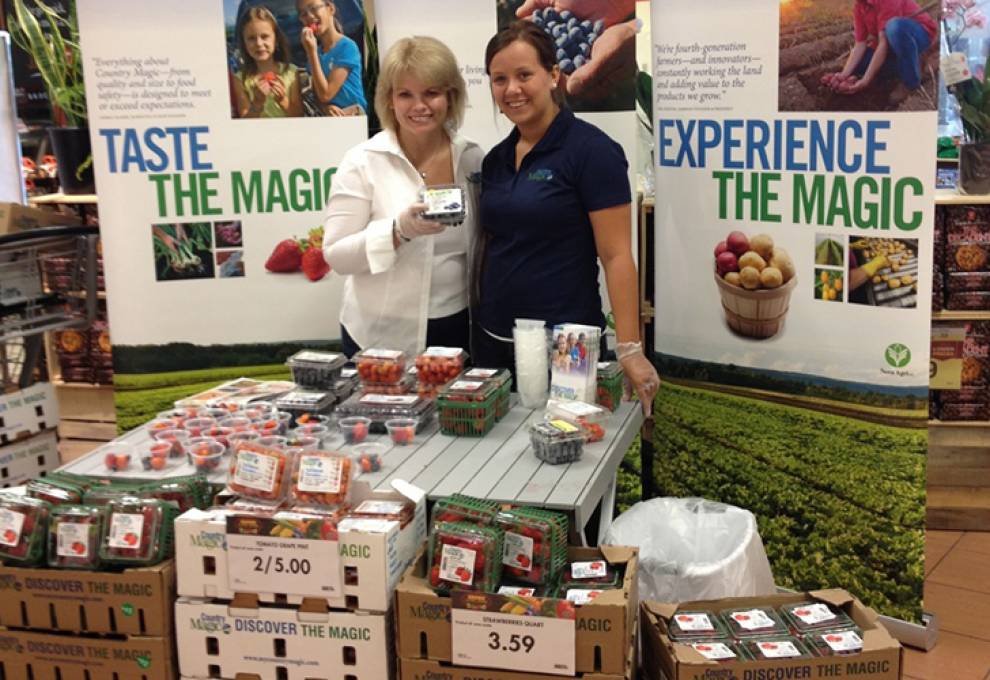
Finding the most effective tools to drive sales should be a priority in your business. Chances are consumers understand a tomato or a potato, however if you have a new variety they will want to try it. Product demonstrations or demos are often very effective, however they are also very costly.
A demo really lifts your product above the noise. When consumers stop to try your product, the amount of focus they give your item is disproportionately greater than the others. When you think there are approximately 35,000 stock-keeping units (SKUs) in the average store, how many of these items do consumers really think about buying? If your product is being sampled it will move to the top one per cent!
There is no secret to the success of the demos at Costco where they make it part of the listing process and the execution is very good. People go to Costco looking for products to sample so they can decide whether or not to buy.
You have to accept a certain number of consumers will just eat or drink for free. No different than advertising, many will read your message but never take action. The key is getting the ones who will buy to actually pick up the item and put it in the cart.
You need to be working on demos before, during and after
Before the demo
Most of the large retailers (with the exception of Costco) will use a third party to coordinate and execute demos. Personally I believe this is wrong because it takes one of the most effective tools for suppliers and retailers and adds a lot of complexity to the process. The retailer really is looking at demos as a revenue-generating tool as opposed to a sales tool. Think of it as them renting the space. It is reality so you have to work with it.
If you are participating in the retailer’s locally grown campaign, often they want the grower to do the demo. This is so much more effective than the third party. I would encourage you to make plans for this. It is difficult because they want you there when you are trying to harvest. If possible it is very valuable to find people in your organization who can take the day or two to go to the stores. Think of it as the cheapest market research you can do. Challenge your employees to bring back information from consumers and make it a project as opposed to just handing out samples. Take a few minutes to make sure they know what to say and how to talk to the consumer.
There are a number of very important things to do in advance of the demo to ensure success:
1. Develop a relationship with the demo company or the store personnel and make sure you know who to communicate with.
2. Provide the person doing the sampling with information about the product, how to prepare or sample and a list of frequently asked questions (FAQs) for the item. Remember these people are working for you and they need to understand your item. Do not assume they know anything about your product or what to do with it.
3. Coordinate inventory through the retailer’s warehouse and to the stores. Most demos are never on a retailer’s merchandising plan so you have to ensure the inventory flows through to the store on time. Make sure you allow for an increase in sales. There is nothing worse than investing in a demo and running out of stock part way through. Great to sell it all but what a missed opportunity!
4. Talk to your category manager about the demo and the expected sales lift. Often they never even know about demos so make sure you get credit for doing it and agree on the expected sales lift. They might have some prior knowledge from other products in the category.
5. Coordinate delivery of signage and coupons or other point-of-sale (POS) materials. The distribution channel will be slow so make sure you allow enough time. Retailers have enough challenges getting their own POS to their stores on time so don’t expect they will do it for you. These stores are big so even if it gets to the store it can take two to three days to be found.
6. Demos are very costly. One option is to consider a complementary partner. This helps reduce your costs and might provide a better experience for the consumer.
7. Promote the demos on social media. Let consumers know when and where. This can become very powerful if the retailer shares it with their followers because usually they have thousands. This is very valuable if the actual grower will be there.
8. Set targets for the demo sales and the new baseline after the demo is done.
9. Clear your schedule to be in the stores on the demo days.
During the demo
While the demo is happening you need to be a part of the action. This is the only way you will ensure you get the return on your investment and learn for the next one.
1. Create a checklist for the people conducting the demos to ensure their time is effective. Think about what you want to learn. If you are paying for the demos you need to visit the stores to ensure you are getting value for your investment.
2. If you are paying for the demos and they are in a number of stores enlist other people in other geographic areas of your business to help with the store checks. This gets them engaged and gives you important information. Provide them with the checklist.
3. Take photos of the demos and post them on social media.
4. Talk to the demo people (if you are using a third party) and get feedback. They do this all the time, so they can assess the consumer response.
5. Talk to the consumers at the demos. People love it when they feel like they have input into products and if you share a little behind the scenes information.
6. Track the sales results. If your item went into the warehouse prior to the demo ask your retailer to help you understand the sales during the demo.
7. Email a photo to the category manager. This tells them you are in the stores and it is a chance for you to remind them you are doing your part to drive sales.
After the demo
The follow up after the demo is just as important as the work prior to the sampling. You need to have the information to determine if this is worth the investment and be able to answer the question: should we do it again?
1. Get the sales through the front end prior to, during and after the demo. You will only know if the baseline sales increase if you get all three of these sales numbers. The goal should be to deliver a new baseline after you have invested in the demo. Compare the results to the targets you set.
2. Do a post mortem of all the tings that went well with the demo and the opportunities for improvement next time.
3. If your store checks proved you did not get 100 per cent execution (it happens more than you think) go back to the demo company for free demos in the future.
4. Follow up with the retailer to share the results and agree on the benefits.
THE OTHER SIDE OF THE DESK
Meet in a store
Category managers don’t get to spend nearly as much time in stores as they should. They get stuck in their office and part of the glue that binds them to the office is meetings with suppliers. Often they will book full days of back-to-back meetings with one supplier after another.
One opportunity to differentiate you from the crowd is to suggest meeting at a store. This gives them an opportunity to schedule some time in the store and then you can meet where it all happens. No sales ever happen at the office.
You can stand in front of the category to see what it really looks like. Most stores have space to sit down with a coffee and have a brief meeting. My experience has been that many meetings in stores focus on the future where as meetings in the office can be stuck in the past.
If you have some ideas to make demos more effective please give me a call at (902) 489-2900 or send me an email at pchapman@gpsbusiness.ca.

Add new comment